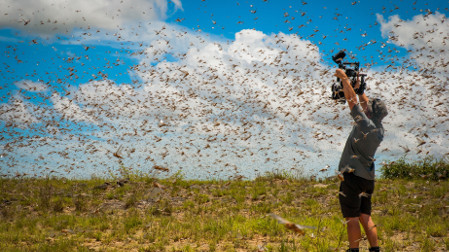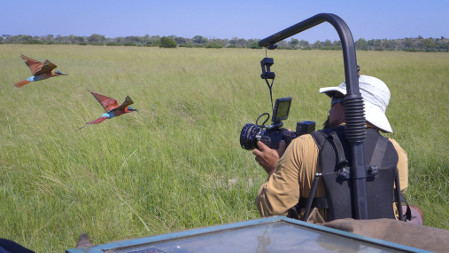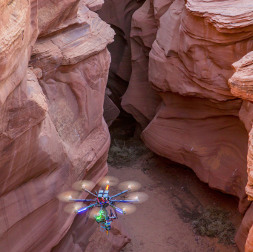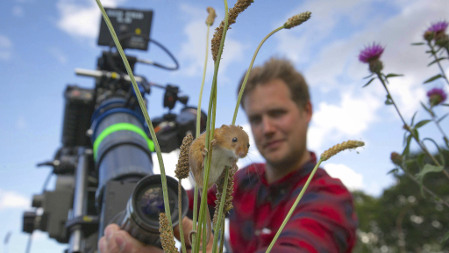The Epic Production of ‘Planet Earth II’
Thanks to a steady stream of advances in digital video technology, BBC’s “Planet Earth II” manages to capture wild animal behavior within some of the world’s most exotic environments in ways that would have been cinematically impossible a decade ago, when the original “Planet Earth” wowed viewers around the world.

Cinematographer Rob Drewett and the team were able to put themselves in the flight path of this super-swarm in southwest Madagascar. Drewett used the latest in handheld, gyro-stabilized camera technology to get shots that flew alongside the locusts, as if part of the swarm. (Photo by Ed Charles/BBC
“Planet Earth” (2006) holds the distinction of being the first natural history series to be filmed in HD. Its successor, “Planet Earth II,” was filmed in ultra-high definition (UHD) and features technological innovations including ultra-lightweight and portable camera stabilization technology that can be carried by camera operators and drones, higher-resolution camera traps for filming elusive animals, miniature camera grip equipment such as macro sliders, jibs and scopes, and 4K low-light cameras with greatly increased light sensitivity.
Narrated by David Attenborough, the six-part “Planet Earth II” premieres in the United States on Feb. 18 on BBC America. It debuted on BBC One in the United Kingdom in November. The series is a BBC Studios Natural History Unit production, co-produced with BBC America, ZDF, Tencent and France Télèvisions.
“Planet Earth II” was over three years in the making, with camera crews traveling to 40 different countries on 117 filming trips and 2,089 shooting days, tracking the living unseen world that inhabits the deserts, forests, islands, jungles and major cities of our planet.
Show producers harnessed advanced production technology to deliver an immersive feel to “Planet Earth II.” According to executive producer Mike Gunton, “Visually, where ‘Planet Earth’ took an almost God-like perspective and said, ‘Let’s look down on the Earth and see the scale of the planet,’ what ‘Planet Earth II’ is doing is saying, ‘Let’s get ourselves into the lives of the animals and see it from their perspectives.’ The visual signature of the series is that you feel like the camera is with the animals. It’s very fluid, very active.”

Cameraman Brad Bestelink films carmine bee-eaters while strapped into a safety harness on the front of a vehicle in Botswana. (Photo by Chadden Hunter/BBC)
Get the TV Tech Newsletter
The professional video industry's #1 source for news, trends and product and tech information. Sign up below.
Mark MacEwan is one of several veteran cinematographers deployed for the project. He was involved in the “Jungles” and “Urban” episodes, and served as primary filmmaker for the “Islands” content, where he captured a battle between two Komodo dragons, as well as a piece about an indri lemur used in the show’s main title sequence.
“From the beginning I was particularly interested in creating as immersive an experience as I could, using gimbal technology, sliders, jibs and such,” MacEwan says. “We used this immersive technology in the hope that—where the environment and the animals allowed—we could take viewers on a journey with the characters, rather than the more traditional long-lens observational style.”
MacEwan says the production crew tried to marry the long lens with the gimbal movements as much as possible. “I’ve always been interested in moving the camera and bringing the action to viewers, and jungle and urban environments are great for that since they’re so multidimensional. There’s so much to move through, layers upon layers, that they keep the eye and mind engaged. You can use movement to reveal characters and find characters, create mood and so much more.
“I worked exclusively with the RED Dragon camera,” MacEwan continues. “I love it. It gives me so many different options in frame rates and resolutions, and its size and form factor mean I can use it for long-lens shots, macro work, or even on my Freefly MoVI M15 [motorized gimbal stabilizer]. It’s incredibly versatile, and the fact that it’s modular is really useful. It proved to be one of the key pieces of equipment for me for the whole series.”
MacEwan’s primary lens during the shoot was a Canon 50-1000mm PL. “It gives me the ability to shoot an entire sequence—from wides to filling the frame with claws and teeth when needed. The glass is beautiful, and optically it’s the best long lens I’ve used. The only downside is that it’s heavy. What you gain in quality, you pay for in weight. But I’m happy to live with that.”

'Planet Earth' drone operator Nick Wolcott piloted a large drone through the narrow walls of this slot canyon in Utah. He succeeded in getting images of these incredible structures in a way that’s never been done before. (Photo by Ed Charles/BBC)
MacEwan deployed a Canon 30-300 PL mount for jungle work, which he used to shoot the indri lemur in Madagascar. “The jungle is very thick. That lens is able to give me beautiful results even in low light. For macro work, the lens I always go to is the incredible ARRI/Zeiss Master Macro. I really wish I owned one of these. The bokeh is stunning and the lens is super-fast.”
Cinematographer John Aitchison worked on the “Jungles” and “Cities” episodes. He helped film the Wilson’s bird of paradise for “Jungles,” as well as hyenas in Ethiopia and catfish in France for “Cities.” Also for “Cities,” he filmed the peregrine falcons that call New York City home.
Like MacEwan, Aitchison says immersion was the name of the game. “The bird I was filming—along with Tim Laman and Edwin Scholes—was Wilson’s bird of paradise. It lives low in the forest; the males make courtship displays on the ground. We used a cable dolly to move the camera at the bird’s eye level to show the tangled nature of their home and the importance of patches of light, where trees have fallen. The camera was mounted on a DJI Ronin [three-axis gimbal], making it possible to pull the dolly along by hand without camera wobble. We could pan, tilt, focus, monitor and record the shot remotely. Tim and Ed also used a drone to show how tree falls create light gaps in the forest, which are useful to the birds,” Aitchison says.
In “Planet Earth II,” the display of the Wilson’s bird of paradise is revealed from its true perspective—from above—as the female would see it. The crucial shot of a male revealing his iridescent plumage to a female bird of paradise was captured using a Canon EOS 1D-C attached to a tree and operated remotely using a CamRanger wireless DSLR remote and an iPad. “This behavior had never been filmed from above before—or even seen, for that matter—and revealed exactly what the female birds see when they watch a male displaying. It was so dark on the forest floor. I shot on a Sony a7S, using a separate recorder to monitor and make the 4K recording, and a Canon Cine-Servo 50-1000mm lens attached by a Metabones Smart Adapter,” says Aitchison.
Aitchison filmed peregrine falcons hunting for prey among the iconic skyscrapers of Manhattan for “Cities.” Peregrines have made their homes in the city’s skyscrapers, which perform the role of cliff edges, the traditional habitat for peregrine falcons. New York City has the highest concentration of nesting peregrine falcons in the world. Aitchison strove to film reflections and abstract views of the city from the birds’ high perspective to show how unnatural and confusing the city could appear to a bird. “The main challenge was not so much to immerse people in the birds’ environment but to film such fast-moving birds before they disappeared between the buildings!”

Cinematographer Jonathan Jones focuses his lens on a harvest mouse climbing grass stems in a wild meadow in Norfolk, England. Filming the smallest rodent in Europe required specialized “scope” lenses that could extend into the grass and away from the bulky 4K camera. (Photo by Chadden Hunter/BBC)
To shoot a massive swarm of locusts in Madagascar for the deserts episode, cinematographer Rob Drewett chose a RED Dragon Carbon Fiber camera package. Much of Drewett’s work, like MacEwan’s, was conducted with a Freefly MoVI M15, which he says allowed him to get stable footage up close to his subjects.
Though locusts are usually solitary, the crew filmed a swarm of several billion. A swarm of this size may only be seen once a decade and is one of the largest ever caught on film. The swarm in “Planet Earth II” stretched over 115 square miles. It could travel up to 62 miles and consume 44,000 tons of vegetation per day.
Drewett continues, “I used Nikon still lenses: 16mm, 20mm, 35mm and 85mm. I have a set of these since they’re all very light, and consistently so. When in the thick of the action, you don’t want to waste time rebalancing the gimbal, so having them nearly the same [weight] allows for a quick swing of the lens. With an RTMotion follow focus that I was able to control with a thumb wheel, I was a completely ‘independent’ cameraman, allowing me to keep up with the [locust] swarm. We also had a Teradek Bolt for wireless video, which allowed the director/producer to watch the footage from afar, and foolcontrol, an iOS app that allowed me to use RED Wi-Fi to access the internal menu for changes in frame rate and other settings,” Drewett says.
Despite the relative dearth of 4K consumers so far, Aitchison believes it’s good to be filming the natural history series at higher resolution “because the quality shines through. Even the least technically equipped audience can recognize it.”
He adds, “I do wish the viewfinders had kept pace with the cameras’ resolutions—especially as the new larger sensors mean depth of field has been halved, more or less, for any given magnification and light level. That makes it hard to follow focus on a hyena, for example, let alone a peregrine diving at 200 miles per hour. But there has been some progress recently. The latest RED viewfinder and those ARRI Amira and VariCam viewfinders are all great improvements.”
